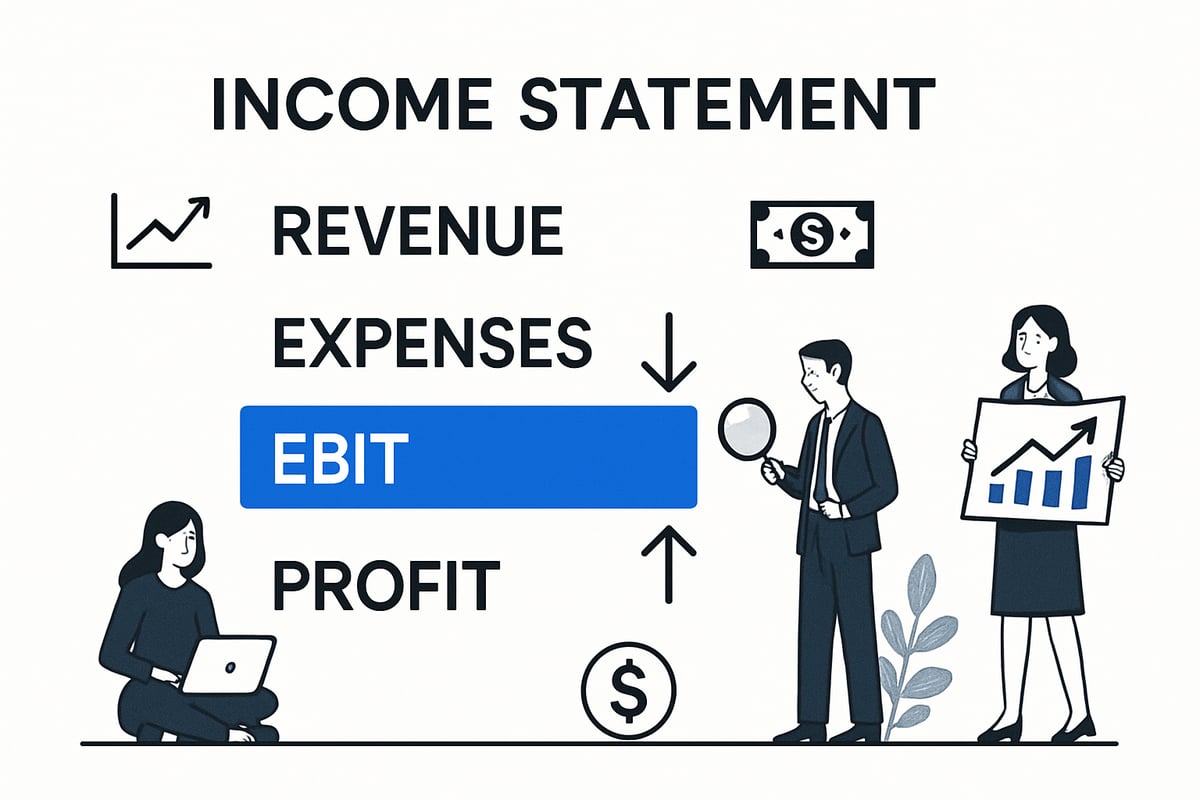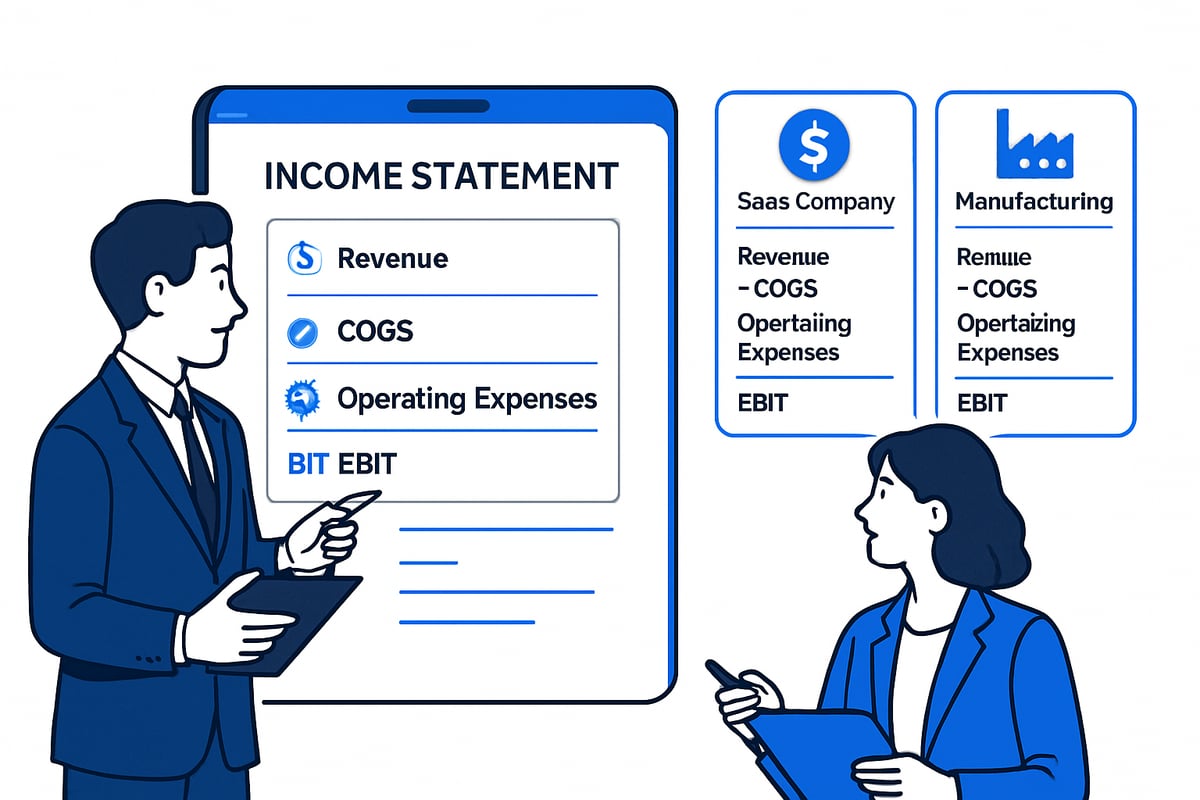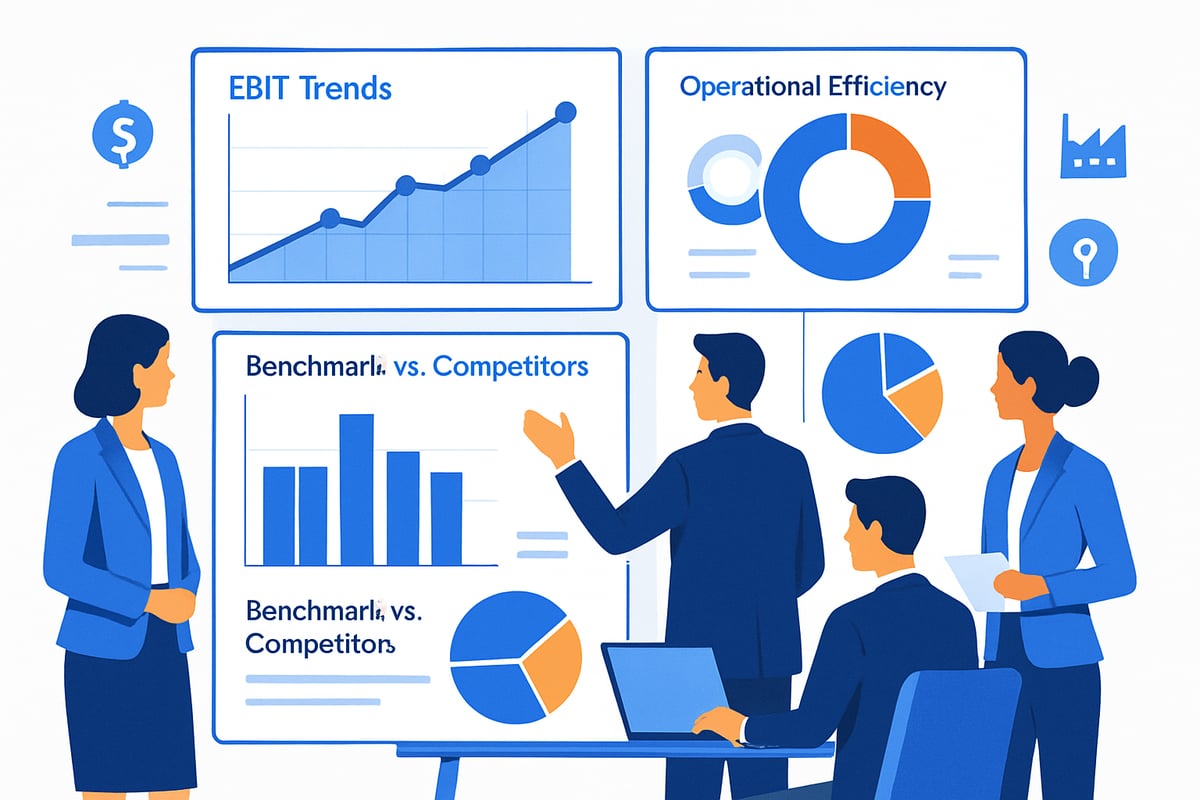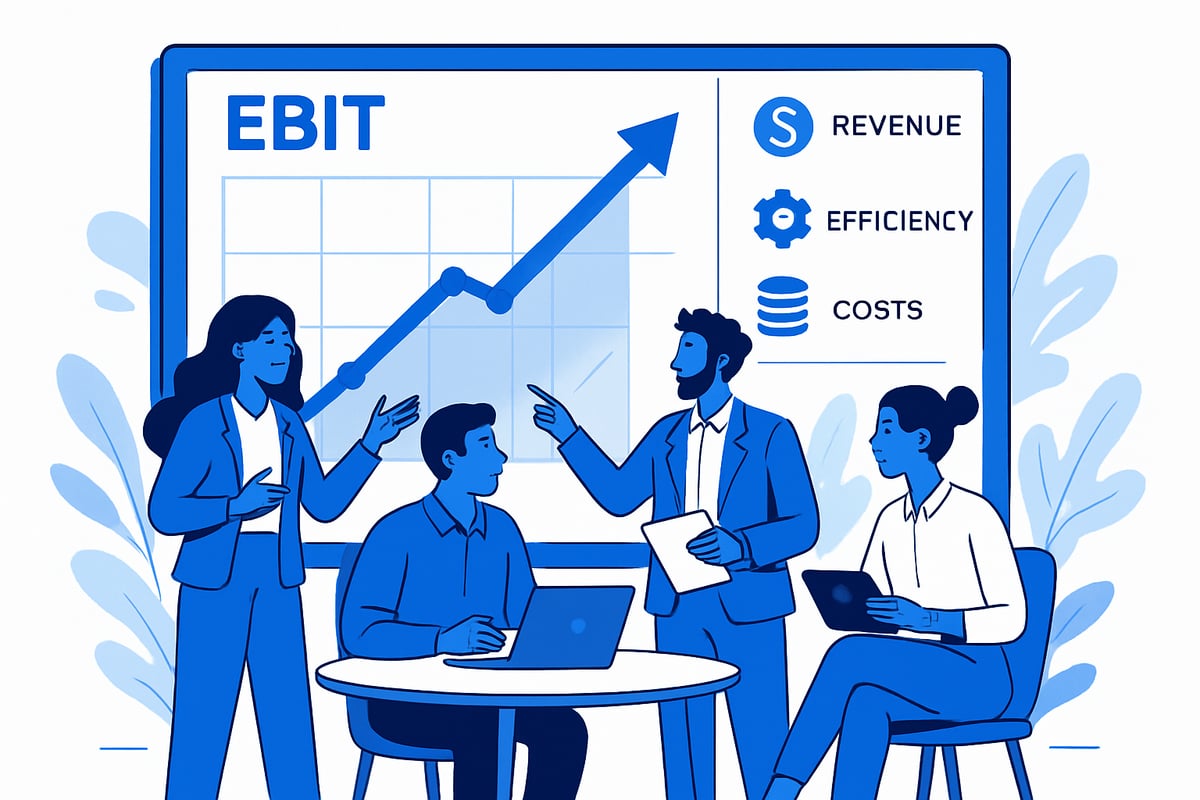EBIT Guide 2025: Unlocking Business Profitability
Imagine unlocking your business’s true earning potential in 2025 by mastering just one financial metric: ebit. This foundational guide is designed to demystify ebit, empowering you to make smarter, more profitable decisions for your company.
We’ll break down what ebit is, explain why it matters, and reveal how to calculate and leverage it for growth. You’ll also discover strategic uses, common mistakes to avoid, and actionable steps for optimizing ebit. Ready to transform your approach to profitability? Dive in and start harnessing the power of ebit today.
Understanding EBIT: Definition and Importance
Unlocking the potential of your business starts with understanding the financial metrics that matter most. Among these, EBIT stands out as a critical indicator of operational success. Let’s break down what EBIT means, why it’s a go-to metric for analysts and executives, and how it compares to other profitability measures.

What is EBIT?
EBIT, or Earnings Before Interest and Taxes, is a financial metric that measures a company’s operating profitability. It represents the profit a business generates from its core operations, before accounting for interest expenses and income taxes. EBIT appears as a key subtotal on the income statement, often labeled as operating profit or operating earnings.
To calculate EBIT, subtract the cost of goods sold (COGS) and operating expenses from total revenue. For example, if a company reports $500,000 in revenue, $200,000 in COGS, and $150,000 in operating expenses, its EBIT is $150,000. For a comprehensive overview, see the EBIT definition and importance.
Why EBIT Matters for Business Performance
EBIT is a core metric for evaluating how efficiently a business runs its day-to-day operations. Investors, creditors, and financial analysts use EBIT to compare companies without the noise of differing tax rates or financing structures. This focus on pre-tax, pre-interest profitability makes EBIT especially valuable for both public and private companies.
In fact, EBIT is a standard subtotal in financial reporting for over 80% of S&P 500 firms. Its widespread use underlines its importance in providing a clear, comparable snapshot of business performance across industries and markets.
EBIT vs. Other Profitability Metrics
How does EBIT compare to metrics like net income, EBITDA, and gross profit? Unlike net income, EBIT strips away interest and tax effects, focusing on a company’s core operational results. EBITDA goes a step further by excluding depreciation and amortization, which can be significant for capital-heavy industries. Gross profit, meanwhile, only considers revenue minus COGS.
Here’s a quick comparison:
| Metric | Focus | Excludes |
|---|---|---|
| EBIT | Operating profit | Interest, Taxes |
| EBITDA | Cash operating profit | Interest, Taxes, D&A |
| Gross Profit | Direct production efficiency | Operating expenses, others |
For capital-intensive firms, EBIT offers a clearer picture than EBITDA, as it includes depreciation and amortization linked to significant asset investments.
Key Scenarios Where EBIT is Essential
There are several situations where EBIT becomes crucial for business analysis and decision-making:
- Mergers and acquisitions: Buyers assess target company EBIT to gauge operational strength.
- Internal benchmarking: Management uses EBIT to track performance against goals.
- Credit analysis: Lenders rely on EBIT to evaluate debt servicing ability.
- Industry comparisons: Analysts compare EBIT margins for peer benchmarking.
A real-world example? Investors often use EBIT to compare SaaS firms, revealing which ones turn revenue into operating profit most effectively. In these scenarios, EBIT provides actionable insights for strategy and growth.
EBIT Calculation: Formulas, Steps, and Examples
Unlocking the power of ebit starts with knowing how to calculate it accurately. Whether you're reviewing a SaaS startup or a global manufacturer, understanding ebit calculation is essential for clear financial analysis. Let’s break down the process step by step, so you can confidently assess profitability in any business scenario.

EBIT Formulas Explained
When calculating ebit, you’ll typically use one of two main formulas:
| Formula | When to Use |
|---|---|
EBIT = Net Income + Interest + Taxes |
When you start with net income at the bottom of the income statement. |
EBIT = Revenue – COGS – Operating Expenses |
When you have direct access to revenue and expenses at the top of the statement. |
Net income is the company’s profit after all expenses. Interest and taxes are added back because ebit focuses on operating results, not financing or tax strategies.
Revenue is total sales, COGS (Cost of Goods Sold) is what it costs to produce goods or deliver services, and Operating Expenses cover everything else required for operations, like salaries and rent.
Both formulas yield the same ebit figure if applied correctly. Choose based on which financial statement data is most accessible for your analysis.
Step-by-Step EBIT Calculation
Let’s walk through a chronological guide to calculating ebit from a typical income statement:
- Identify Relevant Line Items: Locate revenue, COGS, and operating expenses.
- Adjust for Non-Operating Items: Exclude items not related to core business, such as investment gains or losses.
- Handle One-Time Charges: Remove extraordinary gains or losses for a clean ebit number.
- Apply the Formula: Subtract COGS and operating expenses from revenue, or add back interest and taxes to net income.
For a detailed walkthrough with practical examples and common pitfalls, check out this EBIT calculation methods guide.
Practical Examples Across Industries
EBIT calculation can look different depending on the industry. For a SaaS company, revenue is mostly subscription-based, and COGS is usually low. Here's a quick example:
Revenue: $5,000,000
COGS: $500,000
Operating Expenses: $2,000,000
EBIT = $5,000,000 - $500,000 - $2,000,000 = $2,500,000
In manufacturing, COGS is much higher due to materials and labor:
Revenue: $5,000,000
COGS: $2,500,000
Operating Expenses: $1,200,000
EBIT = $5,000,000 - $2,500,000 - $1,200,000 = $1,300,000
Comparing these ebit figures helps you see operational differences and industry-specific challenges.
Common Calculation Mistakes and How to Avoid Them
Avoiding errors is crucial for reliable ebit reporting. Watch out for these common pitfalls:
- Misclassifying Non-Operating Items: Only include core business activities.
- Overlooking Depreciation/Amortization: These are operating expenses and must be included.
- Double-Counting Interest or Taxes: Don’t subtract them twice if using the net income formula.
- Ignoring Extraordinary Items: Adjust for one-time events for a true ebit.
To ensure accuracy, always double-check your inputs and review calculations for consistency.
Tools and Software for EBIT Analysis
Modern accounting platforms can simplify ebit analysis. Tools like ProfitWell Metrics automate calculations, track trends in real-time, and integrate with your broader financial dashboards.
Benefits of using dedicated software include:
- Real-time ebit tracking for quick insights
- Automated calculations to reduce manual errors
- Seamless integration with other analytics tools
In fact, automated analytics can reduce ebit calculation errors by 30%, helping you focus on strategic decisions rather than manual number crunching.
EBIT in Strategic Business Analysis
Understanding how to wield ebit in strategic business analysis can be a game changer for your company’s profitability and decision-making. Let’s break down the essential ways this metric can transform your operational and financial strategies.

EBIT for Operational Efficiency Assessment
Tracking ebit over time helps you pinpoint where your operations are excelling and where they need improvement. By analyzing ebit margins, you can measure efficiency and detect trends that might otherwise go unnoticed.
For example, a SaaS company might monitor ebit margin quarterly, setting performance targets and celebrating improvements. This approach turns raw numbers into actionable insights. When ebit margins rise, it’s a sign your team is optimizing processes and controlling costs. If margins fall, you know exactly where to investigate and adjust.
- Set ebit targets for teams
- Compare periods to spot trends
- Use findings to drive process improvements
EBIT in Investment and Valuation Decisions
Investors and analysts rely on ebit to value companies, especially when comparing those with different debt levels or tax situations. Using ebit-based multiples like EV/EBIT ensures apples-to-apples comparisons regardless of capital structure.
Private equity firms, for instance, often use ebit to assess acquisition targets. A strong ebit shows robust core profitability, making a business more attractive. Did you know that over 60% of M&A deals use EV/EBIT multiples as a valuation benchmark? This underscores why ebit remains central in high-stakes investment decisions.
Credit Analysis and Debt Management
Lenders look closely at ebit to evaluate a company’s ability to service its debt. By calculating ratios like the interest coverage ratio (ebit divided by interest expense), creditors gauge financial health and risk.
Suppose a company wants better loan terms. By improving its ebit, it demonstrates stronger earnings and greater capacity to handle debt payments. This can directly influence the interest rate offered and the willingness of banks to extend credit.
- Monitor ebit to maintain healthy coverage ratios
- Use ebit trends to negotiate better loan terms
- Signal financial strength to potential creditors
Peer Benchmarking and Industry Comparison
Comparing ebit margins with industry peers is vital for understanding your market position. Adjustments for sector-specific factors ensure fair comparisons, whether you’re in SaaS or manufacturing.
For example, SaaS firms typically have higher ebit margins due to lower COGS, while manufacturers may have slimmer margins but higher revenues. Creating an ebit margin table for your sector can highlight where you stand and what’s possible.
| Company | EBIT Margin | Industry Avg |
|---|---|---|
| Your Firm | 18% | 16% |
| Top Competitor | 20% | 16% |
| Industry Avg | 16% | 16% |
Use these insights to set realistic goals and outperform competitors.
EBIT vs. EBITDA: Strategic Implications
While ebit measures core operating performance, EBITDA goes a step further by excluding depreciation and amortization. The choice between the two depends on your industry and analysis needs.
In capital-intensive industries, EBITDA may overstate profitability since it ignores significant non-cash expenses. For asset-light sectors, ebit often provides a clearer picture of true performance. To dive deeper into these distinctions, see EBIT vs EBITDA differences.
Consider ebit for operational analysis and EBITDA for cash flow assessments. Always match your metric to your strategic goal.
Limitations of EBIT in Business Analysis
Despite its strengths, ebit has limitations. It excludes capital expenditures, depreciation, and non-operating items, which can paint an incomplete picture. Companies might also manipulate ebit by reclassifying expenses.
For a holistic view, supplement ebit with other metrics like cash flow. Analysts recommend this approach to avoid being misled by a single number. Remember, ebit is powerful but not infallible—use it alongside other indicators to make the best decisions.
Optimizing EBIT: Strategies for Profitability Growth
Unlocking higher ebit isn’t a mystery—it’s about implementing practical, proven strategies tailored to your business. Whether you’re aiming for rapid expansion or steady, sustainable growth, focusing on the right levers can elevate your ebit to new heights in 2025.

Revenue Growth Tactics Impacting EBIT
Growing revenue is often the fastest way to boost ebit, but it’s more than just selling more. Consider diversifying revenue streams to reduce risk and stabilize cash flow. Smart pricing strategies—like value-based pricing or strategic discounts—can increase top-line growth without sacrificing margins.
Upselling and cross-selling to existing customers are efficient tactics that directly impact ebit. For example, a SaaS firm that increases recurring revenue through bundled services often sees a steady rise in ebit margins. The mix of revenue sources also matters; high-margin products or services will have a more significant effect on your bottom line.
Curious about how these strategies fit into broader financial analysis? Here’s a helpful overview of EBIT in financial analysis.
Cost Management and Expense Reduction
Effective cost management is essential for improving ebit. Start by streamlining operating expenses—eliminate unnecessary spending and optimize resource allocation. Negotiating better terms with suppliers can reduce your cost of goods sold (COGS), directly improving ebit margins.
Implementing technology, such as automation or workflow optimization tools, helps cut labor costs and enhance productivity. For instance, a manufacturing company that automates parts of its production line often sees substantial reductions in COGS. Tracking these cost savings over time allows you to measure their real impact on ebit.
Improving Operational Efficiency
Operational efficiency is a powerful driver of ebit growth. Process optimization, like adopting lean management principles, can reveal hidden inefficiencies. Investing in employee training or productivity tools leads to smoother workflows and fewer costly mistakes.
Reducing waste—whether it’s time, materials, or energy—further strengthens ebit. Imagine a service firm that shortens project turnaround times: not only does it serve more clients, but it also increases its ebit by making better use of existing resources. Small improvements compound over time, making operational efficiency a cornerstone of sustained profitability.
Strategic Investment Decisions
Every investment decision should be evaluated by its potential impact on ebit. Prioritize capital allocation toward projects and initiatives with the highest expected contribution to ebit. Analyze the return on investment (ROI) by projecting how each option will affect operating profit.
Avoid over-investing in low-margin activities or underperforming business units. For example, a retailer that decides to close unprofitable stores can see an immediate uplift in ebit. Strategic divestments free up resources for higher-growth opportunities, ensuring your ebit remains on an upward trajectory.
Monitoring and Forecasting EBIT
Setting clear ebit targets and key performance indicators (KPIs) keeps your team focused on the right outcomes. Use rolling forecasts and scenario planning to anticipate changes in your operating environment. Analytics tools provide real-time insight, allowing for quick adjustments if performance drifts from your ebit goals.
Companies leveraging real-time ebit dashboards often respond 15% faster to negative trends. Early detection means you can address issues before they erode profitability. Consistent monitoring and proactive forecasting are critical for keeping ebit growth on track.
Case Studies: Real-World EBIT Optimization
Many companies have transformed their profitability by focusing on ebit. Take a SaaS company that reduced customer churn through improved onboarding and support—this directly increased recurring revenue and lifted ebit by 10%. Another example is a manufacturer that streamlined supply chains, realizing significant cost savings and boosting its ebit margin.
Key lessons include:
- Focusing on high-impact changes first
- Measuring results regularly
- Avoiding common pitfalls like neglecting operational costs
By learning from these real-world successes, you can design your own roadmap for ebit optimization and sustainable growth.
Advanced EBIT Insights for 2025 and Beyond
As we look toward 2025, understanding ebit requires staying up-to-date with evolving financial standards and business realities. The landscape for ebit analysis is shifting, shaped by new regulations, technology, and priorities like sustainability. Let’s explore the most impactful trends and strategies for leveraging ebit as a future-ready metric.
EBIT in the Context of Evolving Accounting Standards
Recent and upcoming changes in accounting rules have a direct effect on how ebit is calculated and presented. New revenue recognition standards, for example, can shift when and how income is recognized on the income statement, potentially impacting reported ebit. Companies must carefully review updates to ensure compliance and consistency.
Staying current means regularly reviewing financial guidelines and adjusting processes as needed. If your business operates internationally, consider how global accounting changes might alter your ebit figures. For instance, the adoption of IFRS 15 required many firms to modify their revenue calculations, which in turn affected ebit reporting. For definitions of key terms related to these changes, consult the Financial terms glossary.
Industry Trends Shaping EBIT Analysis
Industry dynamics are rapidly transforming how ebit is interpreted and used. The rise of SaaS and digital-first business models has brought recurring revenue streams into focus, making ebit margins more stable and predictable than ever before. Automation and remote work are reshaping cost structures, often leading to lower operating expenses and higher ebit.
SaaS firms, in particular, report ebit margins 5-10% higher than traditional software companies. This shift highlights the importance of benchmarking ebit within your industry. It’s crucial to understand how trends like digitization and new service models might affect your company’s ebit performance compared to peers.
EBIT and ESG (Environmental, Social, Governance) Considerations
Environmental, social, and governance (ESG) initiatives are now a vital part of strategic planning, and they can significantly impact ebit. Investments in sustainability—such as adopting energy-efficient technology or improving supply chain ethics—often require upfront costs that may reduce ebit in the short term.
However, these investments can drive long-term profitability and risk reduction. For example, a manufacturing firm investing in green technology may see a temporary dip in ebit but benefits from lower energy costs and enhanced brand reputation over time. Balancing short-term ebit goals with ESG commitments is increasingly important for future-focused businesses.
Leveraging Technology for EBIT Optimization
Technology is transforming ebit management through automation, data analytics, and artificial intelligence. Real-time dashboards and predictive modeling tools allow companies to forecast ebit with greater accuracy and respond quickly to emerging trends. Integrating ebit tracking with enterprise resource planning (ERP) systems means finance teams can spot risks and opportunities faster.
Firms using AI-powered analytics have seen ebit forecasting errors reduced by 20%. By automating repetitive calculations and visualizing trends, businesses can ensure their ebit reporting is both timely and actionable. This tech-driven approach helps leaders make smarter, data-backed decisions.
Preparing for the Future: EBIT in Strategic Planning
Forward-thinking organizations are embedding ebit into their long-term strategies. Scenario analysis is used to test how market shifts or economic downturns could impact ebit, allowing leaders to plan for both growth and risk. Executive compensation and board-level decisions are increasingly tied to ebit trends, aligning incentives with operational performance.
Aligning ebit targets with other financial health metrics, such as those found in the Debt-to-equity ratio insights, provides a more holistic view of business strength. As you prepare for the future, ensure your planning process integrates ebit as a central metric for sustainable growth and resilience.
Frequently Asked Questions About EBIT
Navigating the world of ebit can be tricky, especially with so many financial terms and reporting practices. Here, we answer the most common questions to help you build confidence in understanding and using this essential metric.
Common EBIT Questions Answered
What’s the difference between ebit and operating income? In most cases, these terms are interchangeable, but sometimes companies adjust ebit for certain items, while operating income sticks to strict accounting definitions. Is ebit a GAAP metric? While widely used, ebit itself isn’t a GAAP line item, but it’s easy to calculate from GAAP statements.
How do taxes and interest affect ebit? Ebit is calculated before deducting interest and taxes, offering a clear view of core profitability. Can ebit be negative? Yes, and when it is, that signals the company’s operations aren’t generating enough profit before financing costs and taxes. When choosing between ebit and EBITDA, remember EBITDA excludes depreciation and amortization, while ebit includes them. Wondering how ebit compares to other ratios? Check out this Understanding quick ratio guide for a broader perspective.
EBIT Calculation in Special Situations
Sometimes, calculating ebit gets complicated. You may need to adjust for non-recurring items, such as one-time gains or losses, to get a clearer picture of ongoing profitability. In consolidated financial statements, ebit should reflect the combined operations, while standalone statements focus on a single entity.
International companies must adjust ebit for foreign currency effects and inflation, ensuring comparability across regions. For example, a multinational firm might recalculate ebit to account for fluctuating exchange rates between subsidiaries. Always review footnotes in financial statements to see if any special adjustments were made to ebit.
EBIT Reporting Best Practices
Clear and accurate ebit reporting builds trust with stakeholders. Always disclose how you calculated ebit, especially if you’ve made adjustments for unusual or extraordinary items. Avoid common pitfalls, such as double-counting expenses or omitting key details.
Align your ebit reporting with investor expectations by following standard industry practices. For public companies, stay up-to-date with regulatory requirements to ensure transparency. When discussing debt management and ebit, it’s helpful to understand related concepts like what is a sinking fund, which can impact how companies plan for future obligations and maintain healthy financial ratios.
Now that you’ve seen how mastering EBIT can transform your business decisions and boost profitability, imagine having the power to explore these concepts in action—across decades of financial history. With Historic Financial News, you don’t just read the numbers; you discover the stories, patterns, and lessons behind them. If you’re excited to deepen your understanding and shape the future of financial analysis, I’d love for you to Join as a Beta User. Let’s unlock new insights together and make business strategy smarter, one historical lens at a time.
